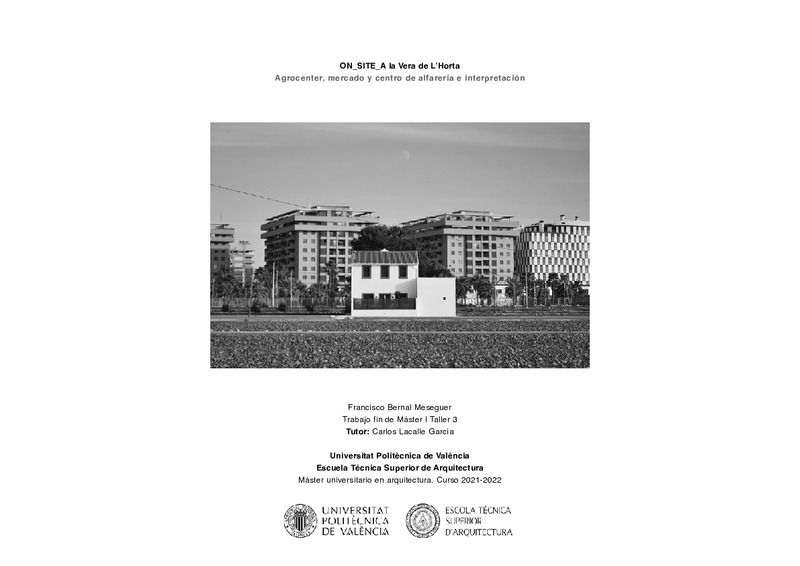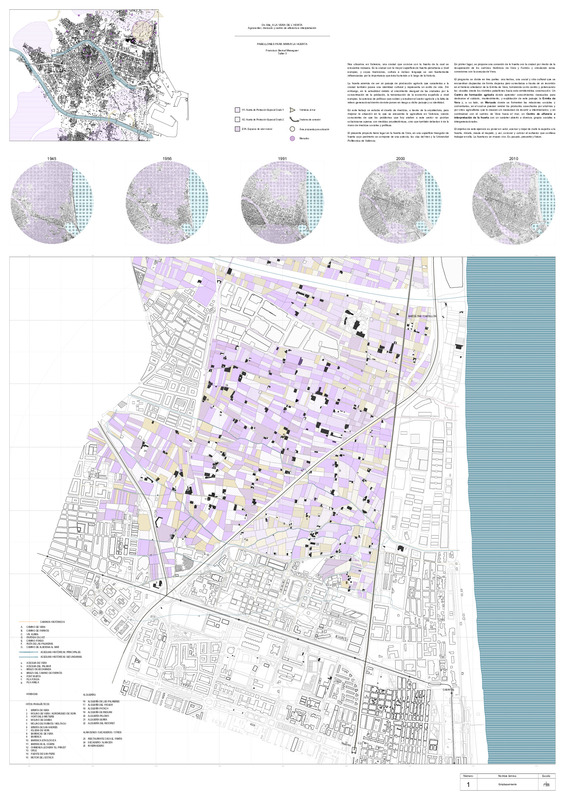JavaScript is disabled for your browser. Some features of this site may not work without it.
Buscar en RiuNet
Listar
Mi cuenta
Estadísticas
Ayuda RiuNet
Admin. UPV
On_Site_A la Vera de l'Horta: Agrocenter, mercado y centro de alfarería e interpretación
Mostrar el registro sencillo del ítem
Ficheros en el ítem
| dc.contributor.advisor | Lacalle García, Carlos
|
es_ES |
| dc.contributor.author | Bernal Meseguer, Francisco
|
es_ES |
| dc.coverage.spatial | east=-0.33401787297572927; north=39.48657436966351; name=Camí de Farinós, 64, 46022 València, Valencia, Espanya | es_ES |
| dc.date.accessioned | 2022-07-12T10:49:08Z | |
| dc.date.available | 2022-07-12T10:49:08Z | |
| dc.date.created | 2022-05-18 | |
| dc.date.issued | 2022-07-12 | es_ES |
| dc.identifier.uri | http://hdl.handle.net/10251/184025 | |
| dc.description.abstract | [ES] Nos situamos en Valencia, una ciudad que convive con la huerta de la cual se encuentra rodeada. Es la ciudad con la mayor superficie de huerta periurbana a nivel europeo, y cuyas tradiciones, cultura e incluso lenguaje se ven fuertemente influenciadas por la importancia que ésta ha tenido a lo largo de la historia. La huerta además de ser un paisaje de producción agrícola que caracteriza a la ciudad también posee una identidad cultural y representa un estilo de vida. Sin embargo, en la actualidad debido al crecimiento desigual de las ciudades por la concentración de la población, la tercerización de la economía española a nivel europeo, la carencia de políticas que cuiden y ensalcen el sector agrícola y la falta de relevo generacional dentro de éste ponen en riesgo a dicho paisaje y su identidad. En este trabajo se estudia el diseño de medidas, a través de la arquitectura, para mejorar la situación en la que se encuentra la agricultura en Valencia, siendo conscientes de que los problemas que hoy atañen a este sector no podrían solucionarse apenas con medidas arquitectónicas, sino que también deberían ir de la mano de medidas sociales y políticas. El presente proyecto tiene lugar en la huerta de Vera, en una superficie triangular de huerta cuyo perímetro se compone de una autovía, las vías del tren y la Universitat Politècnica de València. En primer lugar, se propone una conexión de la huerta con la ciudad por medio de la recuperación de los caminos históricos de Vera y Farinós y vinculando estas conexiones con la acequia de Vera. El programa se divide en tres partes: una lectiva, una social y otra cultural que se encuentran dispuestas de forma dispersa pero conectadas a través de un recorrido en el terreno alrededor de la Ermita de Vera, tomándola como centro y potenciando las visuales desde los distintos pabellones hacia esta emblemática construcción. Un Centro de formación agrícola donde aprender conocimientos necesarios para dedicarse al cuidado, mantenimiento, y explotación de este paisaje; la Ermita de Vera y, a su lado, un Mercado donde se fomenten las relaciones sociales y comunitarias, en el cual se puedan vender los productos cosechados por alumnos y por otros agricultores que lo deseen sin necesidad de recurrir a intermediarios; y en continuidad con el camino de Vera hacia el mar, un Centro de alfarería e interpretación de la huerta con un carácter abierto a diversos grupos sociales e intergeneracionales. El objetivo de este ejercicio es poner en valor, acercar y dejar de darle la espalda a la huerta, mirarla, desde el respeto, y así, conocer y valorar el esfuerzo que conlleva trabajar en ella. La huerta es un museo vivo. Es pasado, presente y futuro. | es_ES |
| dc.description.abstract | [EN] Our location is Valencia. This city coexists with the vegetable gardens it is surrounded by. In fact, Valencia is the city with the largest suburban agricultural land area in Europe. Agriculture has been key throughout Valencia¿s history, and has strongly influenced its traditions, culture and even its language. The gardens define the city¿s characteristic landscape of agricultural production and, on top of that, they hold a cultural identity and represent a whole lifestyle. However, this landscape and culture are currently at risk. This is due to the population¿s uneven growth concentrating in urban areas, Spain¿s transformation into a service-based economy within Europe, the lack of agricultural policies protecting and highlighting this sector, and the lack of generational replacement. This work seeks to improve the situation of agriculture in Valencia through architecture. Nevertheless, we are aware that architectural policies cannot currently solve, by themselves, all the issues this sector is facing. This proposal should be carried out in combination with social and political policies. The following project takes place in the Vera gardens. This is a triangle-shaped agricultural area enclosed by the railway, the highway and the Polytechnic University of Valencia. Our first proposal is to connect the gardens and the city by reconditioning the historical rural paths of Vera and Farinós. These connections will be linked to the Vera irrigation ditch, The program splits down into three parts: a teaching space, a social space and a cultural space. These spaces are scattered around the Vera chapel. We lay out a route connecting these spaces in a way that centers and highlights the chapel¿s emblematic view from each pavilion. In the Agricultural training center students can learn the necessary skills to take care, maintain and exploit this landscape. Next to the Vera chapel, the Farmer¿s market is a social space for the community where students and other farmers can sell their crops without intermediaries. Following the rural path of Vera towards the sea, the garden¿s Pottery and interpretation center is an open space for a variety of social and intergenerational groups. The aim of this work is to highlight the value of the gardens. To bring them closer and to no longer turn our backs on them. To contemplate them respectfully in order to learn and appreciate the efforts farmers put into them. The gardens are a living museum. They are past, present and future. | es_ES |
| dc.format.extent | 171 | es_ES |
| dc.language | Español | es_ES |
| dc.publisher | Universitat Politècnica de València | es_ES |
| dc.rights | Reconocimiento - No comercial (by-nc) | es_ES |
| dc.subject | Huerta periurbana | es_ES |
| dc.subject | Mercados | es_ES |
| dc.subject | Huerta | es_ES |
| dc.subject | Horta Nord | es_ES |
| dc.subject | Agrocenter | es_ES |
| dc.subject | Alfarería | es_ES |
| dc.subject | Garden | es_ES |
| dc.subject | Valencia | es_ES |
| dc.subject | Market | es_ES |
| dc.subject | Interpretation | es_ES |
| dc.subject.classification | PROYECTOS ARQUITECTONICOS | es_ES |
| dc.subject.other | Máster Universitario en Arquitectura-Màster Universitari en Arquitectura | es_ES |
| dc.title | On_Site_A la Vera de l'Horta: Agrocenter, mercado y centro de alfarería e interpretación | es_ES |
| dc.title.alternative | On_Site_A la Vera de l'Horta: Agrocenter, farmer s market, and pottery and interpretation center | es_ES |
| dc.title.alternative | On_Site_A la Vera de l`Horta: Agrocenter, mercat y centre de alfarería e interpretació | es_ES |
| dc.type | Tesis de máster | es_ES |
| dc.rights.accessRights | Abierto | es_ES |
| dc.contributor.affiliation | Universitat Politècnica de València. Departamento de Proyectos Arquitectónicos - Departament de Projectes Arquitectònics | es_ES |
| dc.contributor.affiliation | Universitat Politècnica de València. Escuela Técnica Superior de Arquitectura - Escola Tècnica Superior d'Arquitectura | es_ES |
| dc.description.bibliographicCitation | Bernal Meseguer, F. (2022). On_Site_A la Vera de l'Horta: Agrocenter, mercado y centro de alfarería e interpretación. Universitat Politècnica de València. http://hdl.handle.net/10251/184025 | es_ES |
| dc.description.accrualMethod | TFGM | es_ES |
| dc.relation.pasarela | TFGM\145673 | es_ES |
Este ítem aparece en la(s) siguiente(s) colección(ones)
-
ETSA - Trabajos académicos [4687]
Escuela Técnica Superior de Arquitectura







